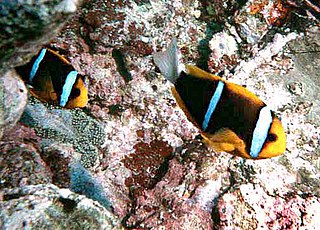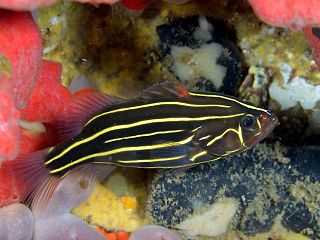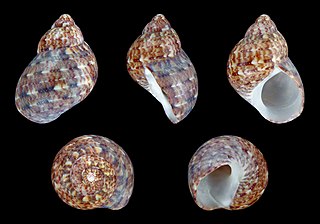
Heteractis magnifica, also known by the common names magnificent sea anemone or Ritteri anemone, is a species of sea anemone belonging to the Stichodactylidae family native to the Indo-Pacific area.

The bristle-thighed curlew is a medium-sized shorebird that breeds in Alaska and winters on tropical Pacific islands.

Abalistes stellatus, the starry triggerfish or flat-tailed triggerfish, is a species of marine ray-finned fish belonging to the family Balistidae, the triggerfishes. This triggerfish has a wide Indo-Pacific distribution.

Hermodice carunculata, the bearded fireworm, is a type of marine bristleworm belonging to the Amphinomidae family, native to the tropical Atlantic Ocean and the Mediterranean Sea.

The orange-fin anemonefish is a marine fish belonging to the family Pomacentridae, the clownfishes and damselfishes, found in the Western Pacific north of the Great Barrier Reef from the surface to 20 m, to include the Pacific Ocean between Queensland, Australia, and New Guinea to the Marshall and Tuamotus Islands. It can grow to 17 cm in length.

The black and white snapper, the black and white seaperch or black snapper, is a species of marine ray-finned fish, a snapper belonging to the family Lutjanidae. It is native to the Indian Ocean and the western Pacific Ocean.

The goldenstriped soapfish, also known as the lined soapfish, golden-striped bass, radio fish, sixline soapfish, six-lined perch or white-lined rock cod, is a species of marine ray-finned fish, related to the groupers and classified within the subfamily Epinephelinae of the family Serranidae. It has a wide Indo-Pacific distribution.

Gymnothorax nudivomer, the starry moray or yellowmouth moray, is a species of marine fish in the family Muraenidae.

The black-side hawkfish, freckled hawkfish or Forster's hawkfish, is a species of marine ray-finned fish, a hawkfish belonging to the family Cirrhitidae. It is from the Indo-Pacific. It is occasionally found in the aquarium trade and is also of minor importance to local commercial fisheries. It grows to a total length of 22 cm (9 in).

Phasianella solida, common name the solid pheasant, is a species of sea snail, a marine gastropod mollusk in the family Phasianellidae.

Stomatella auricula, common name the false ear shell, is a species of sea snail, a marine gastropod mollusk in the family Trochidae, the top snails.
Teuthidodrilus samae, dubbed as the squidworm, is a species of acrocirrid marine annelid worms. It is free-swimming and can be found in the deep sea water column at depths of 2,039 to 2,912 m. It feeds on marine snow and can grow to about 9 cm (3.5 in) in length and 1 cm (0.39 in) in width. It is named for the ten squid-like appendages emerging from its head. It was discovered in 2007 in the benthopelagic zone of the Celebes Sea, near the Tawi-Tawi islands of the Philippines. It is the only species in the genus Teuthidodrilus.

Odontosyllis enopla, commonly known as the Bermuda fireworm, is a polychaete worm that inhabits shallow areas of the western Atlantic Ocean. The organism is bioluminescent when it rises to the surface of the sea during its mating period. It is possible that this fireworm is the explanation of a candle-like light seen by Christopher Columbus during his first voyage on 11 October 1492 before he made landfall in his explorations.

Pycnoclavella diminuta, known as the white-spotted sea squirt, white-spot ascidian, and white-spotted ascidian, is a species of tunicate, in the genus Pycnoclavella. Like all ascidians, these sessile animals are filter feeders.

Chloeia is a genus of marine polychaete worms.

Halichoeres richmondi, commonly called the Richmond's wrasse or chain-lined wrasse, is a fish species in the wrasse family native from the central Indo-Pacific.
Hippichthys cyanospilos, commonly known as the blue spotted pipefish or bluespeckled pipefish, is a marine fish belonging to the family Syngnathidae, native from the Indo-Pacific area.
Zaniolepis frenata, also known as the shortspine combfish, is a species of ray-finned fish belonging to the family Zaniolepididae.The species occurs in the eastern Pacific Ocean.
Eunoe spinosa is a scale worm described from the Sagami Sea, Japan at depths of about 80–100m.

Cephalopholis sonnerati, known as the tomato hind, tomato rockcod, or tomato cod, is a species of marine ray-finned fish, a grouper from the subfamily Epinephelinae which is in the family Serranidae which also includes the anthias and sea basses. It is distributed on coral reefs in the tropical Indo-Pacific. It is also sometimes called the orange-spotted cod, red coral cod, red rockcod, tomato grouper, or tomato seabass.
















